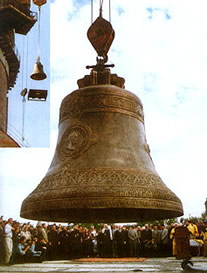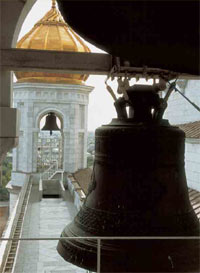 |
 |
|
ZIL made the bells at Christ the Savior Cathedral in Moscow. |
|
Saved by the church bell
By Rebecca Santana
The Washington Times / Cox News Service
Published April 25, 2004
MOSCOW -- As the Soviet Union collapsed more than a decade ago, carmaker AMO ZIL faced a daunting challenge confronting thousands of state-owned enterprises: competing in a brave new world of open markets.
The question was especially troublesome for ZIL, a producer of luxury
limousines used by top Soviet-era Communist Party officials as well as
less-glamorous trucks. Both lines saw plummeting sales as consumers opted
for newly available Western imports.
ZIL, in turns out, was saved by the bell.
Perhaps this is a bit of an exaggeration, but in a bid to diversify,
ZIL began producing church bells, capitalizing on a revival of religion
in post-Soviet Russia and a shortage of bells after most were destroyed
decades ago when the Bolsheviks seized power.
"We simply didn't have anything to do. ... With the beginning of perestroika
[restructuring], there was less work," said Mikhail Mashin, director of
the ZIL factory, explaining the transformation to bell maker. The company
produced about 220,000 vehicles in the late 1980s. This year it made only
17,000.
As Soviet communism and ZIL's vehicle sales began their slide, a professor
of acoustics, Boris Nunin, suggested a new venture to Mr. Mashin. He noticed
that Russian Orthodox churches all over the country were rebuilding after
decades of neglect and destruction under Soviet authorities. The churches
were filled with worshippers who were rediscovering their Orthodox roots.
Mr. Mashin was reluctant at first, but he agreed to allow the ZIL car-design
research laboratory to explore bell making. A decade later, the result
has been the manufacture of more than 3,500 bells for some of Russia's
most famous churches.
During early Soviet times, thousands of churches, monasteries and convents
across the country were destroyed by the Bolsheviks in their drive to
cleanse the Soviet Union of religion. Bells were seen as a potent symbol
of Russian Orthodoxy and a threat to the nascent Soviet power. Across
the country, bells were pushed from their belfries and destroyed.
Russian author Inna Simonova calls it the "aggressive atheism" that
was practiced by the Bolsheviks to sway Russians.
"They said, 'Look, you believe in God, and yet we've thrown these bells
off the roof and nothing has happened,'" said Mrs. Simonova in a telephone
interview from New York, where she is researching a book about one set
of bells that managed to avoid destruction.
Because so many of the bells are replacements, whenever possible the
company uses historical documents describing the destroyed bell in order
to produce a bell of similar size and sound, said Mr. Nunin, the acoustics
expert.
After coming up with the design, a bell-shaped mold is constructed of
wood, metal and plastic, into which is poured a molten bronze mixture.
Once the mixture hardens, the surrounding mold is removed and any rough
edges are smoothed.
The bells are often decorated with relief drawings of saints or the
names of sponsors who have paid for it to be made.
ZIL clients include the massive Christ the Savior Church in downtown
Moscow, which was blown up by dictator Josef Stalin in 1931 and rebuilt
in 1997 to coincide with the city's 850th anniversary.
They also have customers throughout the world, including in Boston,
New York, India, Australia and New Zealand.
"One man ordered a bell for his rancho in Guatemala," said Mr. Mashin.
Bells from the ZIL factory can weigh many tons. The largest bell the
ZIL factory has produced is a 35-ton giant that hangs at a monastery in
Sergiev Posad, a town about 45 miles northeast of Moscow. Mr. Mashin declined
to say exactly how much the bell cost, but pointed out that such enormous
bells are one of a kind -- and that is something a client has to pay a
little extra for.
Mr. Mashin won't say exactly how much of ZIL's business comes from the
bells except to say "not much." The company employs about 20 people who
work specifically on bell-making.
But making bells -- like making limousines -- brings a certain prestige.
Bells made at the ZIL factory hang in some of Russia's best-known churches,
and when a particularly important bell is being made, officials from the
Russian Orthodox Church visit the factory to bless the site and oversee
the process.
The old ZIL limousine may have gone the way of the Soviet Union, but
the bell business is good and likely to remain that way.
"Let me put it this way," said Mr. Mashin. "The Soviets destroyed 40,000 churches in 80 years. To rebuild them will take not 10 or 20 years, but a hundred."
www.washingtontimes.com/world/20040424-105838-4607r.htm